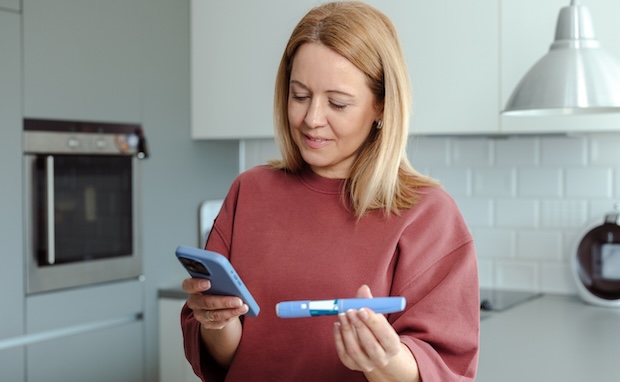Key Points
- Ozempic dosing for weight loss follows a gradual schedule to help your body adapt and minimize side effects.
- The standard Ozempic dose starts at 0.25 mg weekly and typically increases every four weeks to 0.5 mg, 1.0 mg, and up to a maximum of 2.0 mg.
- Significant weight loss usually begins at the higher, therapeutic doses (1.0 mg and 2.0 mg), not the initial starting doses.
- The “best” dose is individual; it’s the lowest dose that gives you effective results with side effects you can manage, a decision you’ll make with your doctor and a registered dietitian.
You’ve heard the buzz about Ozempic for weight loss, and you’re curious about how it actually works. A big piece of that puzzle is the dosing. It’s not as simple as just starting on a high dose and watching the pounds melt away. There’s a specific, science-backed reason for the way Ozempic is prescribed.
If you're wondering what the right Ozempic dosing for weight loss looks like, you're asking the right question. Understanding the dosing schedule is key to managing your expectations, minimizing side effects, and getting the best possible results.
Let’s break down the Ozempic dosing schedule, explain why it’s structured this way, and explore what you can expect at each step of the journey.
Is Wegovy the same as Ozempic?
Before we dive into dosing, it’s important to clear up a common point of confusion. Ozempic and Wegovy are brand names for the same exact drug: semaglutide.
The main difference is their FDA approval. Ozempic is officially approved to help manage blood sugar in adults with type 2 diabetes, with weight loss being a known side effect. Wegovy is specifically approved for chronic weight management.
Because they are intended for different purposes, they come in different pen devices and have slightly different maximum doses (2.4 mg for Wegovy and 2.0 mg for Ozempic). However, since they contain the same active ingredient, the dosing strategy for starting the medication is very similar. Doctors may prescribe Ozempic "off-label" for weight loss, and when they do, they follow a careful dosing schedule.
Why does Ozempic dosing start low and go slow?
Have you ever wondered why you can't just start on the highest dose of Ozempic? The reason is all about managing side effects.
Semaglutide works by slowing down your digestion, which helps you feel fuller for longer. This is great for weight loss, but it can also lead to some unwelcome digestive issues, especially when you first start.
These gastrointestinal issues are the most frequent complaints with drugs like Ozempic, including:
- Nausea
- Vomiting
- Diarrhea
- Constipation
By starting with a very low dose and increasing it gradually over several weeks or months, you give your body a chance to adapt. This "start low, go slow" approach makes the side effects much more manageable.
“Be mindful of your body’s response as you increase your dosage,” says Emily Timm, RD. “GLP1s can be associated with increased risk of anxiety, depression, and related symptoms in predisposed individuals. Take note of anything out of the ordinary. If you have a history of mental health issues, let someone close to you know you’re adjusting your dose.”
A registered dietitian can also provide personalized strategies, like adjusting meal timing and food choices, to help you navigate these side effects. This teamwork increases the chances that you'll be able to stick with the treatment long enough to see results.
The standard Ozempic dosing schedule explained
The Ozempic dosing schedule is designed as a gradual titration plan. Titration simply means adjusting the dose of a medication over time to find the best dose for an individual. Here’s what that typically looks like, based on the manufacturer's prescribing information.
Starting dose: 0.25 mg (weeks 1-4)
Think of this as the "acclimation phase." You'll take a 0.25 mg injection once a week for the first four weeks. The main purpose is to introduce the medication to your system gently. You should expect very little, if any, weight loss. This is not considered a therapeutic dose for weight loss, so don't be discouraged if you don't see changes on the scale during this first month.
Dose increase: 0.5 mg (weeks 5-8)
After four weeks on the starting dose, your doctor will likely increase your dose to 0.5 mg once a week. This is the next step in the titration process. At this stage, you might start to notice some appetite suppression and potentially some minor weight loss. Studies on semaglutide for type 2 diabetes have shown that patients do lose some weight at the 0.5 mg and 1.0 mg doses. A dietitian can help you capitalize on these early changes by crafting a nutrient-dense eating plan that keeps you satisfied.
Therapeutic doses: 1.0 mg and 2.0 mg (month 3 and beyond)
If you’re tolerating the medication well, your doctor may increase your dose to 1.0 mg after four weeks on 0.5 mg. After another four weeks, if more weight loss is needed, you may be moved up to the maximum Ozempic dose of 2.0 mg. These are the primary therapeutic or "maintenance" doses where significant weight loss is expected to occur.
The landmark STEP 1 clinical trial for semaglutide (Wegovy) showed that people taking 2.4 mg lost an average of nearly 15% of their body weight over 68 weeks. This is where the magic happens for most people.
“Overall, dose increases make sense if/when you hit a persistent weight plateau,” says Emily Timm, RD. “It’s best to try to get the most out of each dose, as faster weight loss is not better weight loss! By going more slowly with titration, you may increase the longevity of your results.”
Is there a "best" Ozempic dose for weight loss?
This is a common question, and like most aspects of health, the answer is: it's personal.
While the maximum dose of Ozempic is 2.0 mg (and 2.4 mg for Wegovy), it doesn't mean that will be your personal dose. The goal isn't a race to the highest dose. The "best" dose for you is the lowest dose that produces meaningful weight loss with side effects you can comfortably manage.
Some people find they achieve great results and feel good on the 1.0 mg dose and may not need to increase to 2.0 mg. Others may need the full 2.0 mg dose to see the progress they’re looking for.
This is a three-way conversation between you, your healthcare provider, and your dietitian. Your doctor manages the prescription, while a registered dietitian helps you track how your diet and appetite are responding to each dose, allowing your team to make the most informed decision for your health.
What if my current dose isn't working?
It can be frustrating if you’ve been on Ozempic for a few weeks and the scale isn’t moving. Before you get discouraged, consider these points:
- Be patient with the process. If you’re still on the 0.25 mg or 0.5 mg dose, you haven’t reached a therapeutic level yet. It can take two months or more to get to the 1.0 mg dose where many people start seeing real changes.
- Remember the medication is a tool, not a cure. Ozempic works best when it's part of a bigger plan. The most successful outcomes in clinical trials always involve combining the medication with lifestyle changes. Studies show that implementing behavioral therapy, like working with a dietitian, alongside the medication leads to even greater weight loss.
- Talk to your healthcare team. If you’ve reached the 1.0 mg or 2.0 mg dose and are still not seeing results after several weeks, it's time for a check-in. This is where a registered dietitian is especially critical. They can help troubleshoot a weight loss plateau by analyzing your food choices, portion sizes, and eating patterns to ensure your nutrition plan is fully supporting the medication.
What happens if I miss a dose?
Life happens, and you might forget an injection. Don't panic! The guidance is pretty straightforward. If it has been 5 days or less since you were supposed to take your dose, go ahead and take it as soon as you remember, then take your next dose on your regularly scheduled day.
However, if it has been more than 5 days, just skip the missed dose entirely and take your next dose on your regular day. It's important that you do not take two doses at once to "catch up." This helps keep a stable amount of the medication in your system.
Final thoughts
Ozempic dosing for weight loss is a careful and methodical process designed for your safety and success. The gradual increase allows your body to adapt while minimizing the side effects that could otherwise derail your journey.
Remember that reaching your goal isn't just about the number on the pen; it's about combining this powerful tool with sustainable lifestyle habits. Patience is your best friend in the early months, as it takes time to reach the doses where you'll see the most significant impact.
Navigating these changes can feel overwhelming, but you don't have to do it alone. Creating a team with your doctor and a weight loss dietitian can provide you with a personalized nutrition plan to maximize your results and help you build healthy habits that will last a lifetime.
Frequently asked questions
How much weight can you lose on 0.25 mg of Ozempic?
You should expect to lose very little, if any, weight on the 0.25 mg starting dose. This four-week period is for your body to get used to the medication, not for therapeutic weight loss.
Can you stay on 0.5 mg of Ozempic for weight loss?
Yes, it's possible. If you are experiencing good appetite control and steady, meaningful weight loss on the 0.5 mg dose with minimal side effects, your doctor may decide to keep you there. However, most people need to increase to 1.0 mg or higher to achieve significant weight loss results. A dietitian can help you and your doctor assess if your progress on 0.5 mg is sufficient for your goals.
What is the highest dose of Ozempic for weight loss?
The highest dose for Ozempic is 2.0 mg per week. It's important to note that Wegovy, the version of semaglutide specifically approved for weight loss, has a maximum dose of 2.4 mg per week.
How long does it take to see weight loss on Ozempic?
While some people may notice changes sooner, most significant weight loss begins once you reach the therapeutic doses of 1.0 mg or 2.0 mg. According to the standard titration schedule, this would be after at least eight weeks of treatment.
The views expressed by authors and contributors of such content are not endorsed or approved by Fay and are intended for informational purposes only. The content is reviewed by Fay only to confirm educational value and audience interest. You are encouraged to discuss any questions that you may have about your health with a healthcare provider.
Sources
Fay Nutrition has strict sourcing guidelines and relies on peer-reviewed studies, academic research institutions, and medical associations. We avoid using tertiary references.
- Gastrointestinal adverse events associated with semaglutide: A pharmacovigilance study based on FDA adverse event reporting system - Frontiers in Public Health
- Ozempic - Novo Nordisk
- Semaglutide and Cardiovascular Outcomes in Patients with Type 2 Diabetes - New England Journal of Medicine
- Once-Weekly Semaglutide in Adults with Overweight or Obesity - New England Journal of Medicine
- Effect of Subcutaneous Semaglutide vs Placebo as an Adjunct to Intensive Behavioral Therapy on Body Weight in Adults With Overweight or Obesity - JAMA
- Ozempic Dosing - Novo Nordisk











